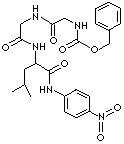|
Z-Gly-Gly-Leu-pNA |
| Synonyms. Z-Gly-Gly-Leu-pNA; Benzyloxycarbonyl-glycyl-glycyl-leucine-4-nitroanilide; N-Benzyloxycarbonylglycyl-glycyl-leucine-4-nitroanilide; Z-Gly-gly-leu-4-nitroanilide; N-((Phenylmethoxy)carbonyl)glycylglycyl-N-(4-nitrophenyl)-L-leucinamide; |
|
|
| PRODUCT IDENTIFICATION |
|
|
CAS RN |
53046-98-3 |
|
EINECS RN |
|
|
FORMULA |
C24H29N5O7 |
|
MOLE WEIGHT |
499.52 |
|
H.S CODE |
2924.29.7100 |
|
SMILES |
C([C@@H](Nc1ccc(cc1)[N+](=O)[O-])CC(C)C)(=O)NC(CNC(CNC(=O)OC c1cc ccc1)=O)=O |
|
CLASSIFICATION |
Tripeptide |
|
EXTRA NOTES |
A sensitive chromogenic substrate for subtilisins and neutral endopeptidases. |
|
|
| PHYSICAL AND CHEMICAL PROPERTIES |
|
|
PHYSICAL STATE. |
white powder |
|
MELTING POINT |
|
|
BOILING POINT |
|
|
DENSITY |
|
|
SOLUBILITY IN WATER |
|
| SOLVENT SOLUBILITY | |
|
VAPOR DENSITY |
|
|
log P(octanol-water) |
|
|
VAPOR PRESSURE |
|
|
AUTOIGNITION TEMP |
|
| pH |
|
|
REFRACTIVE INDEX |
|
|
FLASH POINT |
|
|
|
| STABILITY AND REACTIVITY | |
| STABILITY | Stable under normal conditions. |
|
INCOMPATIBLE MATERIALS |
Strong oxidizing agents |
| POLYMERIZATION |
Has not been reported |
|
NFPA RATINGS |
Health: 1; Flammability: 0; Instability: 0; |
|
|
| EXTERNAL LINKS & GENERAL DESCRIPTION |
|
Wikipedia Linking - Tripeptide PubChem Compound Summary - Z-Gly-Gly-Leu-pNA http://www.ncbi.nlm.nih.gov/ - Z-Gly-Gly-Leu-pNA http://www.peptideguide.com/ Local:
|
|
|
| SALES SPECIFICATION |
|
|
APPEARANCE |
white powder |
|
PURITY |
98.0% min (HPLC) |
|
|
| TRANSPORT & REGULATORY INFORMATION |
|
|
UN NO. |
Not regulated |
| HAZARD SYMBOL |
|
| PACKING GROUP | |
|
|
| SAFETY INFORMATION |
|
|
HAZARD OVERVIEW |
Not known |
|
GHS |
|
|
SIGNAL WORD |
|
|
PICTOGRAMS |
|
|
HAZARD STATEMENTS |
|
|
P STATEMENTS |
|
| EC DIRECTIVES |
|
| HAZARD CODES |
|
|
RISK PHRASES |
|
|
SAFETY PHRASES |
24/25 |
|
|
| PACKING |
|
|
|
|
| PRICE INFORMATION |
|
|
